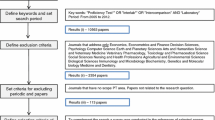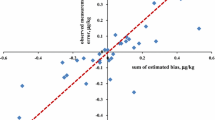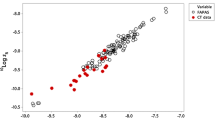Abstract
The organisation of the homogeneity control of samples prepared for proficiency testing schemes (PTS) is a challenge for the PTS organisers and engenders logistical and financial problems. Samples used in PTS need to be homogeneous in order to be sure that if a laboratory has a result different from the other laboratories, its error can be attributed to its analysis method and not to its sample. The present paper describes the solutions found by the Bureau Interprofessionnel d’Etudes Analytiques (Bipea) in order to answer the homogeneity control requirement. The methodologies of homogeneity control are adapted to specific characteristics of the products proposed in Bipea’s PTS. The first methodology of control, the “preparation approach”, concerns specific PTS where the samples are formulated and where the assigned values are known and chosen. The second methodology, the “target approach”, concerns mainly the field of the environment and implies the choice of homogeneity targets. The third methodology, the “global approach”, concerns the agricultural and agro-food fields and involves comparison of near-IR spectra samples. Each methodology of control has its advantages and disadvantage and is suited to specific products prepared with specific preparation procedures. It has to be stressed that the solutions developed answer quality requirements but are not a substitute for the use of adapted and detailed preparation procedures with validated and regularly checked devices and for the a posteriori control of the results of the laboratories.


Similar content being viewed by others
References
International Laboratory Accreditation Cooperation (2000) ILAC G13
Thompson M, Wood R (1993) J AOAC Int 76:926–940
International Standardisation Organisation (1997) ISO Guide 43-1. Proficiency testing by interlaboratory comparisons—part 1: Development and operation of proficiency testing schemes. International Standardisation Organisation, Geneva, Switzerland
International Standardisation Organisation (2002) ISO/DIS 13528 Statistical methods for use in proficiency testing by interlaboratory comparisons. International Standardisation Organisation, Geneva, Switzerland
International Standardisation Organisation (2000) NF EN ISO/CEI 17025. International Standardisation Organisation, Geneva, Switzerland
Comité Français d’Accréditation (2002) COFRAC LAB CIL Ref 02 document. Comité Français d’Accréditation, France</fn>
Gy P (1988) Hétérogénéité, échantillonnage, homogénéisation. Masson, Paris
Van der Veen AMH, Linsinger T, Pauwels J (2001) Accred Qual Assur 6:26–30
Linsinger TPJ, Pauwels J, van der Veen AMH, Schimmel H, Lamberty A (2001) Accred Qual Assur 6:20–25
Thompson M, Lowthian P (1996) Analyst 121: 1593–1596
Lafargue ME, Feinberg MH, Daudin JJ, Rutledge DN (2003) Anal Bioanal Chem 375:496–504
Lafargue ME, Feinberg MH, Daudin JJ, Rutledge DN (2003) J Near Infrared Spectrosc 11:109–121
Author information
Authors and Affiliations
Corresponding author
Rights and permissions
About this article
Cite this article
Lafargue, M.E., Biogeaud, S., Rutledge, D.N. et al. Proficiency testing schemes: solutions for homogeneity control. Accred Qual Assur 9, 333–339 (2004). https://doi.org/10.1007/s00769-003-0754-1
Received:
Accepted:
Published:
Issue Date:
DOI: https://doi.org/10.1007/s00769-003-0754-1




